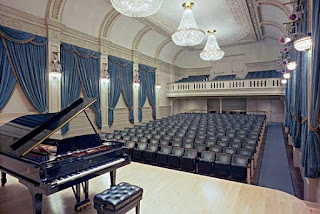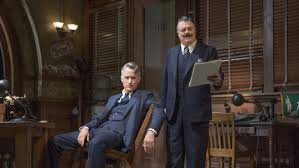READER NOTE: This is clearly deja vu. Last May just days after arriving in Hingham I got to watch a 44 foot sailboat being extracted from the shed where it was constructed (see “Popping the Cork on a 17 Year Old NEW Boat”). Now, three days after arriving in Sarasota I’m driving across the state of Florida to see another brand new boat.
Diana and I met Bob and Jan Kossman in August of 2012 on the second phase of our Great Loop adventure. We had just completed the Trent Severn Waterway, a 240 mile inland waterway journey from Trenton Ontario to Port Severn, a port on the southeast end of the Georgian Bay.
 |
| Diana with Jan & Bob Kossman on Mackinac Island in September 2012 |
Actually, Kodi introduced us to the Kossman’s who were cruising on their 45 foot Tollycraft, Jan’s Tern, with their dogs Kaylee and Daphne. This took place in Penetangiushene Canada. We then proceeded to cruise north with them through the Georgian Bay and the North Channel. We checked back into the United States at Drummond Island and then cruised together to Mackinac Island, where we finally parted company.
 |
Jan’s Tern – Bob’s 1996 45 Tollycraft Cockpit Motor Yacht
Currently for sale. See www.boattrader.com or tollyclassified.com |
Needless to say we’ve been friends every since. Bob and I spoke frequently as we were building the Outer Reef 63 (November 2012 to February 2014). Bob and Jan joined us for the Christening Party that Outer Reef threw at the 2014 Miami Boat Show.
Shortly after we took delivery and moved Guided Discovery north to Massachusetts, Bob began the process of building a custom yacht with Lance Bracewell, owner of Bracewell Marine Group. That process ultimately took 26 months, was done in China and culminated with the arrival of a semi-custom built Bracewell 54 in late September 2016.
From late September to last weekend (November 12), when I visited the Kossman’s and their new yacht in Fort Lauderdale, the boat had been at Cable Marine undergoing six weeks commissioning. Bob and I have been in close communication and I have had the opportunity to vicariously participate in the process of commissioning another new yacht (with all of its frustration – oh well). Now I traveled 200 miles across Florida to view the almost finished product.
Bob, like Burger King, wants to do it his way. So after much searching he found a builder, Lance Bracewell, who was willing to modify an existing hull to meet Bob’s specifications.
Explanatory Note: Three ways to build a boat. Custom: You hire a naval architect and start from scratch with drawings. Everything on the boat is custom designed. You choose all equipment along with interior fabrics and colors. Semi-custom (like Outer Reef and Bracewell): You start with an existing hull and make modifications. You get to choose equipment along with interior fabrics and colors. Stock (the 48 Sundancer): You get to pick equipment from an options list. Interior fabrics are selected from a set of fixed choices.
Reader Note: The photos that follow are of a boat in the later stages of commissioning and thus things are a little messy.
Here’s a photo of the finished product.
 |
| “Vision,” Bob’s 54 Bracewell Semi-custom Motoryacht |
And here’s a photo of the standard Bracewell Pacesetter 54.
Bob moved the flybridge forward a good 6 feet creating an 18 foot flybridge with amazing space including a day head. The bridge is fully enclosed with EZ2CY strata glass and has a fully enclosed hinged door to the boat deck.
 |
| Aft view showing engine room access door, aft deck, boat deck and aft door on flybridge |
Another major modification occurs on the main deck. The standard 54 Pacesetter is a two station boat. Bob’s 54 has a single control station on the flybridge. The elimination of the lower station frees up the that space to become banquette seating for five. The result as you walk forward is a wide open space.
 |
| Standard Pacesetter with pilothouse helm station and surrounding settee. |
 |
| Bob’s banquette across from the galley creates seating with an open feeling |
Now as you sit at the banquette and look aft you have a open space of almost 40 feet.
 |
| Banquette looking aft to the salon. Notice the open stairwell to the flybridge, TV and cabinetry to port. |
Explanatory Note: Bob built and equipped a boat that matches his cruising style. Unlike myself, Bob does not run long distances or offshore or in substantial seas or operate at night. Hence this boat does not have stabilizers, AIS, night vision or satellite radio. Bob picks favorable weather and runs at hull speed most of the time. The boat is capable of 21 MPH when needed.
Here’s the basic specifications:
- Length overall (LOA) 54’ – 0”
- Length on deck (LOD) 51’ – 0”(including integrated swim platform)
- Beam 16’ – 0’
- Draft 3’ – 6”
- Displacement 56,000 lbs.
- Fuel capacity 600 gals
- Water capacity 300 gallons
- Holding tank 150 gallons
- Bridge clearance 19’ 6”
Now for a tour of the main deck.
 |
Bob standing on the aft deck. Storage locker to port.
There is plenty of room for a table with chairs |
 |
| Salon starboard settee and fixed table just forward of the salon door |
 |
| Salon door and port settee with fixed table |
 |
| Lovely fixed table |
 |
| TV and entertainment center – currently awaiting equipment and cabinet doors |
 |
| Galley banquette. Stairwell to the accommodations is to starboard |
 |
| Galley with full size refrigerator and top freezer, 2 burner electric stove, dishwasher and toaster oven |
Bracewell will build the Pacesetter 54 as either a two or three stateroom boat. Both arrangements have two heads. Bob choose the two stateroom arrangement to maximize the size and storage for each room. We’ll start with the starboard side of the master stateroom, continue around that room and then look at the VIP stateroom.
 |
Master Stateroom Vanity with storage
Door to the head and shower is to your left |
 |
| Master queen sized bed |
 |
| Side table with granite top and storage below |
 |
| Starboard storage includes 12 drawers flanked by two hanging lockers. Notice the granite top. |
 |
| Aft hanging locker |
 |
TV, drawers and double door hanging locker
Looking forward to the VIP stateroom |
 |
| VIP standard size bed |
 |
| Storage drawers under the bed |
 |
| VIP TV |
 |
| VIP head |
Now well look at the flybridge. Bob’s decision to build a single station boat maximized space on the main deck and eliminated considerable cost by not having to duplicate electronics. The flybridge is enclosed with EZ2CY strata glass, which can be opened for ventilation. The area has a powerful HVAC unit that makes in usable year round in any weather.
 |
Looking forward to the control station
Notice the starboard settee and fixed table |
 |
Control station with two Garmin 7612s and a Garmin Autopillot
The 54 is equipped with single lever engine controls, a bow thruster and a joy stick |
 |
| Super comfortable ultra leather covered helm seating |
 |
| Starboard settee and table looking aft |
.
 |
| Flybridge sink and storage. Day head to the right. |
 |
| The day head. Inside is a commode |
 |
| Left to right. Day head, door to boat deck.and flybridge refrigerator |
 |
Boat deck. Open space for sun bathing
Bob does not carry a tender. Hence no davit. |
Now we’ll visit the lazarette and the engine room (or holy place as it was called by Bill Parlator, the co-founder of Passagemaker Magazine). The 54 is equipped with two Cummins 530 HP tier 3 (very clean, state of the art) diesel engines. The engine room has over 68 inches of headroom and as you will notice has tremendous space. Literally everything is accessible. To get to the engine room you pass through the lazarette.
 |
| Lazarette starboard side |
 |
| Lazarette storage shelf |
 |
| Washer and dryer and work space |
 |
| More storage space |
 |
| Lazarette looking aft |
 |
| Forward bulkhead and storage lockers |
 |
| Port engine. Notice the space for easy access |
 |
The builder, Lance Bracewell, with Bob Kossman
sitting comfortably on the port storage locker |
Jan and Bob pose for a parting photo.
Suggestion to Lance: Name this model “Vision.”
And to Jan and Bob. She’s a work of art. Good luck and smooth sailing.
Written by Les.



















